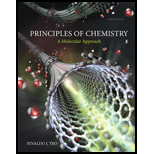
Concept explainers
Interpretation:
The electronic configuration and Lewis structure of  is to be written. The electrons from the electronic configuration, which are included in the Lewis structure are to be shown.
is to be written. The electrons from the electronic configuration, which are included in the Lewis structure are to be shown.
Concept introduction: Electronic configuration is the distribution of electrons in increasing order of their energies. The electrons are filled in various orbitals, according to the following rules.
- The electrons are filled in various orbitals according to their increasing energies.
- An orbital can accommodate only two electrons and both these electrons should have opposite spins.
- The orbitals are singly filled first and after that pairing of electrons takes place.
Lewis structures, also known as Lewis dot structures, are the diagrams that show bonding between various atoms of a molecule. The valence electrons around an atom are shown by dots. Bonds between atoms are shown by lines and the lone pair of electrons is shown by a pair of dots.
To determine: The electronic configuration and Lewis structure of  Also determine the electrons from the electronic configuration, which are included in the Lewis structure.
Also determine the electrons from the electronic configuration, which are included in the Lewis structure.
Want to see the full answer?
Check out a sample textbook solution
Chapter 9 Solutions
Principles of Chemistry: A Molecular Approach (3rd Edition)
 ChemistryChemistryISBN:9781305957404Author:Steven S. Zumdahl, Susan A. Zumdahl, Donald J. DeCostePublisher:Cengage Learning
ChemistryChemistryISBN:9781305957404Author:Steven S. Zumdahl, Susan A. Zumdahl, Donald J. DeCostePublisher:Cengage Learning ChemistryChemistryISBN:9781259911156Author:Raymond Chang Dr., Jason Overby ProfessorPublisher:McGraw-Hill Education
ChemistryChemistryISBN:9781259911156Author:Raymond Chang Dr., Jason Overby ProfessorPublisher:McGraw-Hill Education Principles of Instrumental AnalysisChemistryISBN:9781305577213Author:Douglas A. Skoog, F. James Holler, Stanley R. CrouchPublisher:Cengage Learning
Principles of Instrumental AnalysisChemistryISBN:9781305577213Author:Douglas A. Skoog, F. James Holler, Stanley R. CrouchPublisher:Cengage Learning Organic ChemistryChemistryISBN:9780078021558Author:Janice Gorzynski Smith Dr.Publisher:McGraw-Hill Education
Organic ChemistryChemistryISBN:9780078021558Author:Janice Gorzynski Smith Dr.Publisher:McGraw-Hill Education Chemistry: Principles and ReactionsChemistryISBN:9781305079373Author:William L. Masterton, Cecile N. HurleyPublisher:Cengage Learning
Chemistry: Principles and ReactionsChemistryISBN:9781305079373Author:William L. Masterton, Cecile N. HurleyPublisher:Cengage Learning Elementary Principles of Chemical Processes, Bind...ChemistryISBN:9781118431221Author:Richard M. Felder, Ronald W. Rousseau, Lisa G. BullardPublisher:WILEY
Elementary Principles of Chemical Processes, Bind...ChemistryISBN:9781118431221Author:Richard M. Felder, Ronald W. Rousseau, Lisa G. BullardPublisher:WILEY





